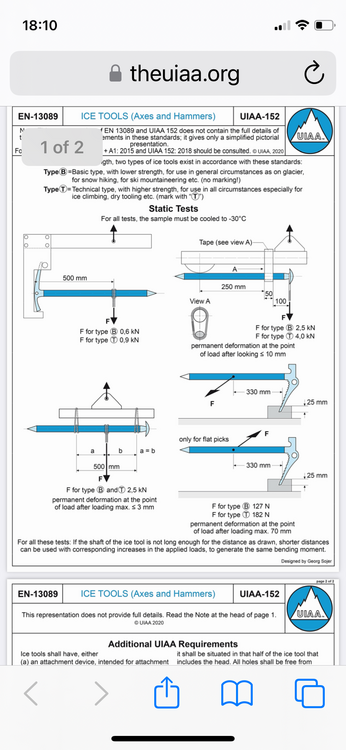Ice Tool Pick Strength?
|
|
If I am reading the below UIAA document correctly then the side pull on a T rated ice tool pick buried ~1 inch in a crack only needs to withstand a force of ~ 40 lbs with a 1 ft lever. IOW, far less than body weight. And, supposing an ice tool with a handle 2 ft from the pick, the force would be half that at 20 lbs. That can’t be right, right? What am I missing here? Or? |
|
|
I think that's the cyclic loading test that torques the pick; so, yes, ~40 ft-lbs for 50000 cycles. Memory tells me that there has been a slight change of some sort in the force/torque/cycles threshold and that B and T pick nomenclature is obsolete. If you're ice climbing, you're using the pick for progression, so basically there is no need for a standard to set thresholds for the pick in the direction ice climbers pull on it. |
|
|
Hi Dave, Thanks for the point about the cyclic loading. That makes more sense. And I take your point about direction of pull for ice progression. I guess I was thinking mostly about mixed climbing where a pull other than along the axis of the shaft would be common and for which 20 lbs at 2 ft would be less than acceptable. |
|
|
The image says 'STATIC TESTS' so those pictured are only done for 1 cycle. I don't think it's an unreasonable test force, I certainly wouldn't expect the rock to hold my bodyweight in that situation. Are people really using 2ft long tools for dry tooling and torqueing them at 90degrees with full bodyweight? |
|
|
Charlie Ward wrote: It isn’t uncommon for ice tools to be subjected to much higher torques than in this test. Traversing horizontal cracks by torquing is uncommon, but it is quite normal to apply high torque while climbing vertical cracks in corner systems. Not necessarily body weight, but feet pressing against a corner wall can apply similarly high forces. I am fairly confident that this is a 50,000 cycle fatigue test and not a static test, assuming the EN standard has not changed recently. FWIW, I have never seen a plastically deformed T-rated pick, except for one case where a climber had a tether fall that shock loaded a tool that was jammed into a thin crack. |
|
|
Fair enough, I haven't seen the EN standard, so I guess there is a chance UIAA have mis-represented the diagrams in the image. If this is a fatigue load, I would expect the failure load to be at least 2-4 times as high. |

 Continue with onX Maps
Continue with onX Maps Sign in with Facebook
Sign in with Facebook





















